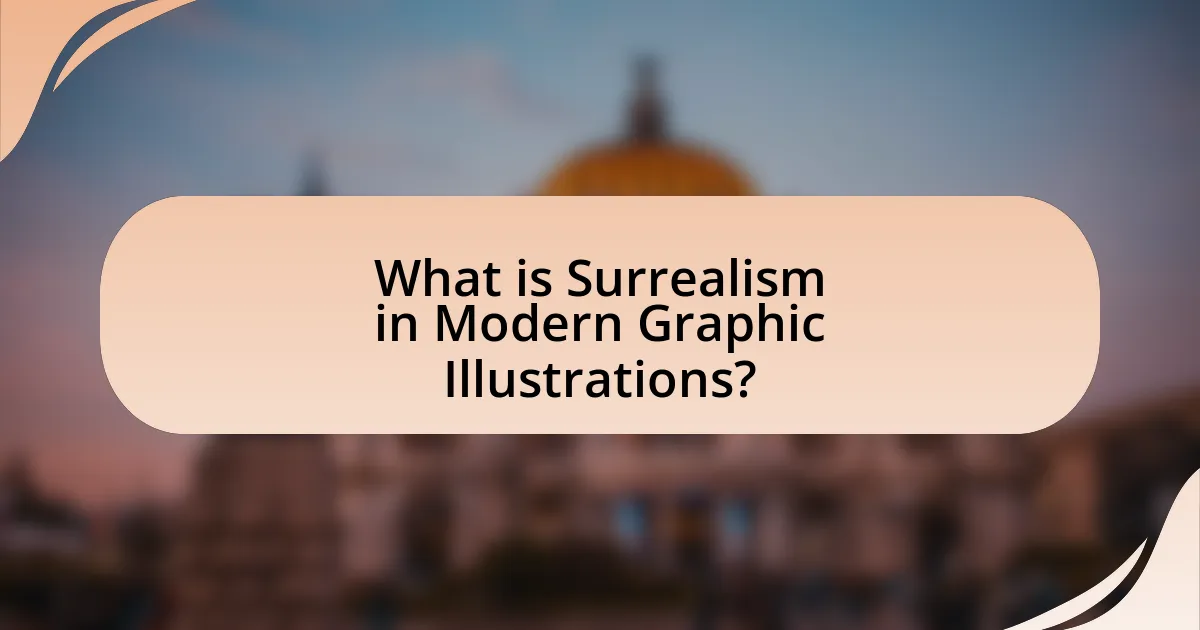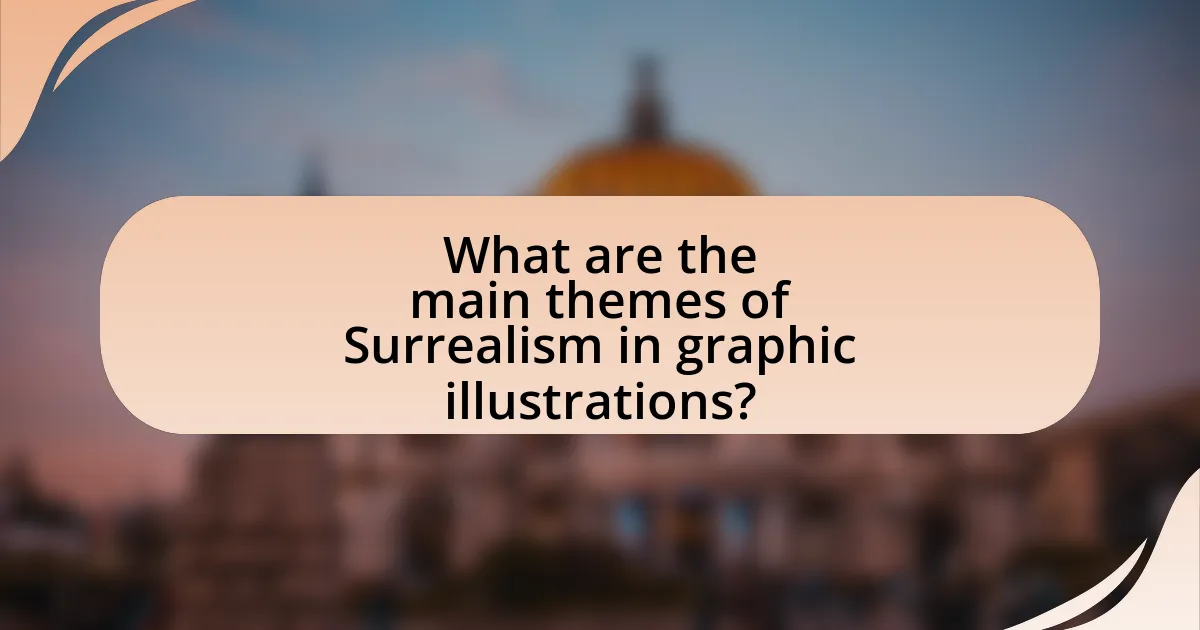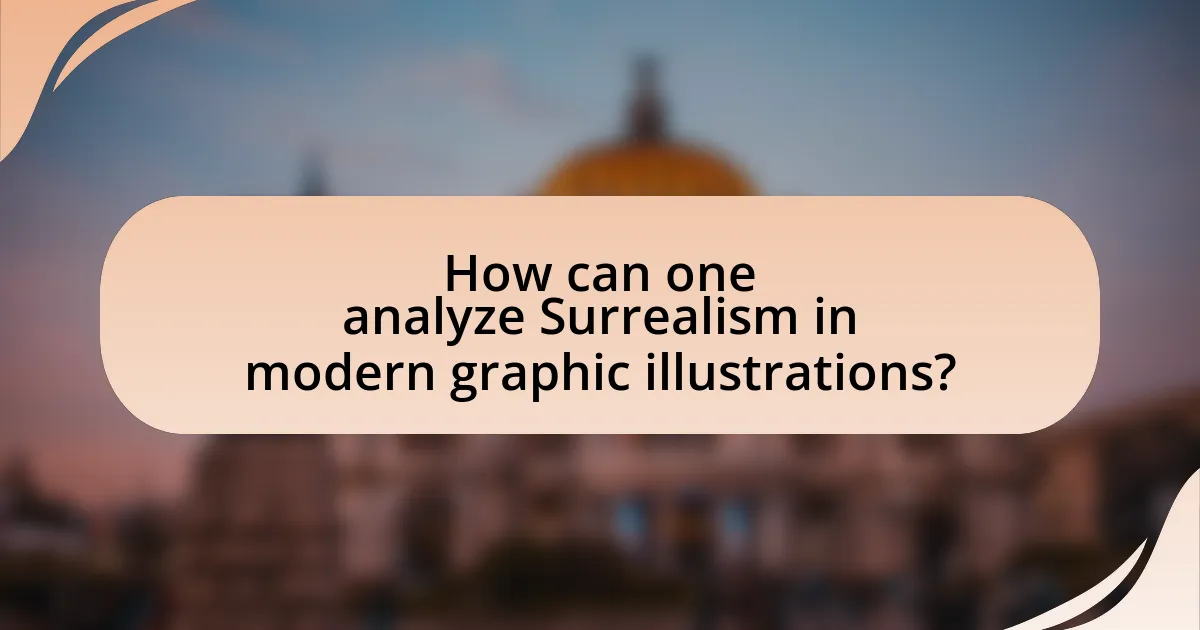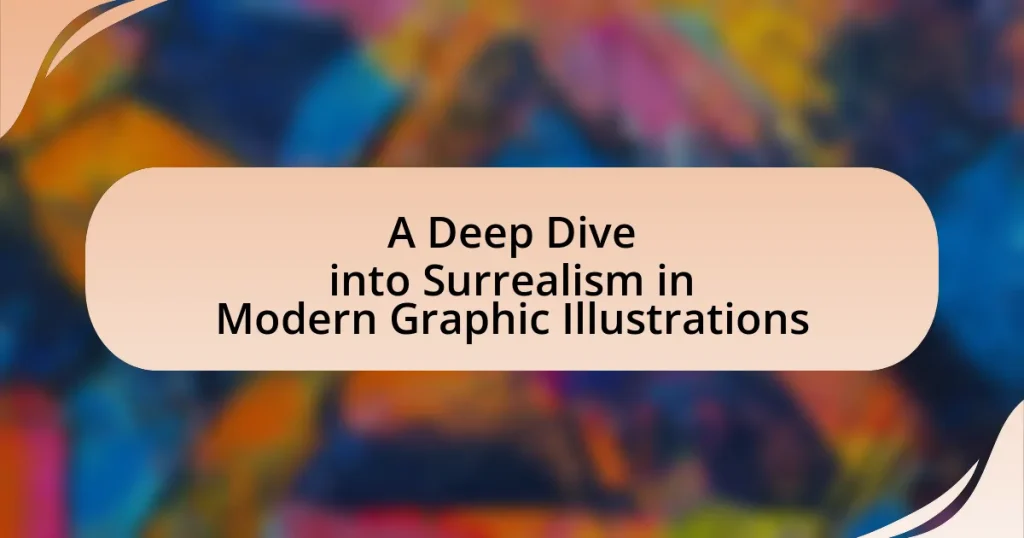Surrealism in modern graphic illustrations is an artistic movement that blends dream-like imagery with unexpected juxtapositions, challenging conventional perceptions of reality. This article explores the influence of Surrealism on contemporary graphic design, highlighting key characteristics such as dream imagery, symbolic representations, and the exploration of the unconscious mind. It examines how modern illustrators incorporate Surrealist elements through techniques like digital manipulation and collage, while also discussing the significance of Surrealism in contemporary art and its evolution influenced by cultural movements. Additionally, the article provides insights into notable examples and leading contemporary artists in Surrealist graphic design, offering practical tips for aspiring artists to integrate Surrealism into their work.

What is Surrealism in Modern Graphic Illustrations?
Surrealism in modern graphic illustrations is an artistic movement that seeks to challenge the conventional perception of reality by blending dream-like imagery with unexpected juxtapositions. This approach often incorporates elements of fantasy, absurdity, and the subconscious, allowing artists to explore complex themes and emotions. For instance, contemporary illustrators like Salvador Dalí and René Magritte have influenced modern graphic design by employing techniques such as distortion, unexpected combinations, and symbolic imagery, which evoke a sense of wonder and provoke thought. The use of surrealism in graphic illustrations can be seen in various media, including advertising, book covers, and digital art, where it serves to captivate audiences and convey deeper meanings beyond the surface.
How did Surrealism influence modern graphic illustrations?
Surrealism significantly influenced modern graphic illustrations by introducing dreamlike imagery and unconventional juxtapositions. This movement encouraged artists to explore the subconscious, leading to innovative visual narratives that challenge reality. For instance, the use of unexpected combinations of objects and distorted perspectives in graphic design can be traced back to Surrealist techniques employed by artists like Salvador Dalí and René Magritte. Their emphasis on the irrational and the bizarre has permeated contemporary graphic art, inspiring designers to create works that evoke emotion and provoke thought through surreal elements.
What are the key characteristics of Surrealism in graphic art?
The key characteristics of Surrealism in graphic art include dream-like imagery, unexpected juxtapositions, and the exploration of the unconscious mind. Surrealist graphic artists often utilize bizarre and fantastical elements to challenge reality and provoke thought. For instance, artists like Salvador Dalí and Max Ernst employed techniques such as automatism and collage to create works that defy logical interpretation. This movement, which emerged in the early 20th century, aimed to tap into the subconscious, revealing hidden emotions and desires through visual representation. The use of symbolism and irrational combinations of objects further emphasizes the surrealist intent to transcend ordinary perception and evoke a sense of wonder or disorientation.
How do modern graphic illustrators incorporate Surrealist elements?
Modern graphic illustrators incorporate Surrealist elements by blending dreamlike imagery with unexpected juxtapositions. They utilize techniques such as digital manipulation, collage, and unconventional color palettes to create visuals that challenge reality. For instance, artists like Salvador Dalí and René Magritte have influenced contemporary illustrators to explore themes of the subconscious and the bizarre, often resulting in artwork that evokes emotional responses and provokes thought. This approach aligns with the Surrealist movement’s goal of transcending logical reasoning, as seen in the works of modern illustrators who often draw inspiration from dreams, fantasies, and the irrational.
Why is Surrealism significant in contemporary art?
Surrealism is significant in contemporary art because it challenges conventional perceptions of reality and encourages innovative forms of expression. This movement, which emerged in the early 20th century, has influenced numerous contemporary artists who utilize dream-like imagery and unexpected juxtapositions to explore the subconscious. For instance, artists like Salvador Dalí and René Magritte laid the groundwork for contemporary practices that question societal norms and personal identity, making surrealism a vital reference point in discussions about artistic freedom and creativity today.
What cultural movements have shaped Surrealism’s evolution?
Surrealism’s evolution has been significantly shaped by Dadaism, Symbolism, and the broader context of modernism. Dadaism, emerging in the early 20th century, rejected traditional aesthetics and embraced absurdity, which influenced Surrealist artists to explore irrationality and dream-like imagery. Symbolism, with its focus on representing emotions and ideas through symbolic forms, provided a foundation for Surrealists to delve into the subconscious. Additionally, the modernist movement, characterized by a break from tradition and experimentation with new forms, encouraged Surrealists to challenge conventional artistic boundaries and explore innovative techniques. These cultural movements collectively contributed to the development of Surrealism as a distinct and influential art form.
How does Surrealism challenge traditional artistic norms?
Surrealism challenges traditional artistic norms by prioritizing the subconscious and dream-like imagery over realistic representation. This movement, which emerged in the early 20th century, rejected the constraints of logic and reason that dominated classical art, instead embracing irrationality and spontaneity. Artists like Salvador Dalí and René Magritte employed unexpected juxtapositions and bizarre scenarios to provoke thought and evoke emotional responses, thereby subverting conventional aesthetics and techniques. The incorporation of automatic drawing and free association further exemplifies how Surrealism sought to unlock creativity beyond the limits of rational thought, fundamentally altering the landscape of modern art.

What are the main themes of Surrealism in graphic illustrations?
The main themes of Surrealism in graphic illustrations include dream imagery, the juxtaposition of unexpected elements, and the exploration of the unconscious mind. Dream imagery often manifests through bizarre and fantastical scenes that challenge reality, as seen in the works of artists like Salvador Dalí. The juxtaposition of unexpected elements creates a sense of surprise and disorientation, which is a hallmark of Surrealist art; for example, René Magritte’s use of ordinary objects in unusual contexts exemplifies this theme. Additionally, the exploration of the unconscious mind is reflected in the use of symbols and motifs that reveal deeper psychological truths, aligning with the theories of Sigmund Freud, who significantly influenced Surrealist thought. These themes collectively contribute to the distinctive visual language of Surrealism in graphic illustrations.
How do dreams and the unconscious mind manifest in graphic illustrations?
Dreams and the unconscious mind manifest in graphic illustrations through surreal imagery, symbolic representations, and dreamlike narratives. Surrealism, as an art movement, emphasizes the exploration of the subconscious, often depicting bizarre scenes that challenge reality. For instance, artists like Salvador Dalí and René Magritte utilized distorted forms, unexpected juxtapositions, and dreamlike landscapes to evoke the complexities of the unconscious. These techniques allow viewers to engage with their own subconscious thoughts and emotions, making the illustrations resonate on a deeper psychological level. The use of vivid colors and abstract shapes further enhances the dreamlike quality, inviting interpretation and reflection on the nature of reality and imagination.
What role does symbolism play in Surrealist graphic art?
Symbolism plays a crucial role in Surrealist graphic art by serving as a vehicle for expressing the unconscious mind and exploring dream-like realities. Surrealist artists, such as Salvador Dalí and Max Ernst, utilized symbols to convey complex emotions and ideas that transcend rational thought, often drawing from personal experiences, mythology, and psychoanalysis. For instance, Dalí’s melting clocks symbolize the fluidity of time and the distortion of reality, reflecting the influence of Freudian theory on the Surrealist movement. This use of symbolism allows viewers to engage with the artwork on multiple levels, prompting introspection and interpretation that align with the Surrealist goal of challenging conventional perceptions of reality.
How do artists depict the irrational and fantastical in their work?
Artists depict the irrational and fantastical in their work by employing surrealism, which combines dream-like imagery with unexpected juxtapositions. This approach allows artists to challenge reality and explore the subconscious mind, often resulting in visuals that defy logical interpretation. For instance, Salvador Dalí’s “The Persistence of Memory” illustrates this by presenting melting clocks in a dreamscape, symbolizing the fluidity of time and perception. Such techniques effectively engage viewers, prompting them to question their understanding of reality and embrace the bizarre elements of imagination.
What are the common techniques used in Surrealist graphic illustrations?
Common techniques used in Surrealist graphic illustrations include juxtaposition, dream imagery, and automatic drawing. Juxtaposition involves placing unrelated elements together to create unexpected associations, a hallmark of Surrealism that challenges conventional perceptions. Dream imagery draws from the subconscious, often depicting bizarre scenes that mimic the illogical nature of dreams. Automatic drawing, a technique where artists create without conscious thought, allows for spontaneous expression and the exploration of hidden thoughts. These techniques collectively embody the Surrealist aim of transcending reality and tapping into the unconscious mind.
How do juxtaposition and unexpected combinations enhance Surrealism?
Juxtaposition and unexpected combinations enhance Surrealism by creating striking contrasts that challenge conventional perceptions of reality. This technique allows artists to juxtapose unrelated elements, provoking thought and evoking emotional responses. For instance, Salvador Dalí’s works often feature bizarre pairings, such as melting clocks alongside dreamlike landscapes, which disrupt logical reasoning and invite viewers to explore deeper meanings. Such combinations stimulate the subconscious mind, aligning with André Breton’s definition of Surrealism as a means to reconcile the dream and reality. This approach not only captivates the audience but also encourages a re-evaluation of the familiar, making Surrealism a powerful medium for artistic expression.
What digital tools are commonly used to create Surrealist illustrations?
Digital tools commonly used to create Surrealist illustrations include Adobe Photoshop, Corel Painter, and Procreate. Adobe Photoshop is favored for its extensive editing capabilities and layering options, allowing artists to manipulate images and create dreamlike compositions. Corel Painter offers a natural painting experience with a variety of brushes that mimic traditional media, which is beneficial for achieving surreal textures. Procreate, popular among digital illustrators, provides a user-friendly interface and powerful features for sketching and painting, making it ideal for creating imaginative and surreal artwork. These tools are widely recognized in the digital art community for their effectiveness in producing surrealistic visuals.

How can one analyze Surrealism in modern graphic illustrations?
One can analyze Surrealism in modern graphic illustrations by examining the use of dream-like imagery, unexpected juxtapositions, and symbolic representations that challenge reality. This analysis involves identifying elements such as distorted forms, unusual color palettes, and the incorporation of subconscious themes, which are hallmarks of Surrealist art. For instance, contemporary artists like Salvador Dalí and René Magritte have influenced modern illustrators to explore the boundaries of perception and imagination, often leading to works that provoke thought and evoke emotional responses. By studying these characteristics, one can understand how modern graphic illustrations continue to reflect and reinterpret Surrealist principles, thereby maintaining the movement’s relevance in today’s visual culture.
What are the key elements to look for in a Surrealist illustration?
Key elements to look for in a Surrealist illustration include dream-like imagery, unexpected juxtapositions, and a sense of the bizarre or irrational. Dream-like imagery often manifests through distorted perspectives and fantastical elements that challenge reality. Unexpected juxtapositions create striking contrasts between unrelated objects or themes, provoking thought and evoking emotion. The sense of the bizarre or irrational is essential, as it reflects the Surrealist aim to explore the unconscious mind and the realm of dreams, often inspired by the works of artists like Salvador Dalí and René Magritte, who utilized these techniques to engage viewers in a deeper psychological experience.
How does context influence the interpretation of Surrealist art?
Context significantly influences the interpretation of Surrealist art by shaping the viewer’s understanding of the cultural, historical, and psychological elements embedded within the artwork. For instance, Surrealism emerged in the early 20th century, a period marked by the aftermath of World War I, which led to a collective questioning of reality and traditional values. This historical backdrop informs how viewers perceive the dreamlike and often irrational imagery characteristic of Surrealist works, as they may interpret these elements as reflections of trauma, subconscious desires, or societal critiques. Additionally, the personal context of the viewer, including their own experiences and knowledge of Surrealist theory, further affects interpretation, allowing for diverse readings of the same piece. Thus, context serves as a crucial lens through which Surrealist art is understood, influencing both emotional responses and intellectual engagement with the artwork.
What questions should viewers ask when engaging with Surrealist works?
Viewers engaging with Surrealist works should ask questions that explore the underlying themes, symbols, and emotional responses evoked by the artwork. Key questions include: What emotions does this piece evoke in me? How do the symbols used in the artwork relate to the unconscious mind? What narrative or story is being suggested through the imagery? How does this work challenge reality or conventional perceptions? These inquiries help viewers connect with the complex layers of meaning often present in Surrealist art, which aims to transcend logical reasoning and tap into deeper psychological experiences.
What are some notable examples of Surrealism in modern graphic illustrations?
Notable examples of Surrealism in modern graphic illustrations include the works of artists like Salvador Dalí, whose iconic melting clocks and dreamlike landscapes have influenced contemporary illustrators. Additionally, the graphic novels of David B. often incorporate surreal elements, blending reality with fantastical imagery, as seen in “Epileptic,” which explores personal and psychological themes through a surreal lens. Another example is the work of artist Yoko Honda, whose vibrant illustrations combine retro aesthetics with surreal landscapes, creating a dreamlike quality. These examples demonstrate how modern graphic illustrations continue to draw from Surrealism, merging imaginative concepts with visual storytelling.
Who are the leading contemporary artists in Surrealist graphic design?
The leading contemporary artists in Surrealist graphic design include Salvador Dalí, Max Ernst, and René Magritte, who have significantly influenced the genre. Salvador Dalí’s iconic melting clocks and dreamlike landscapes exemplify surrealism, while Max Ernst’s innovative techniques, such as frottage and collage, have expanded the boundaries of graphic design. René Magritte’s thought-provoking imagery challenges perceptions of reality, making him a pivotal figure in contemporary surrealism. Their works continue to inspire modern graphic designers and artists, reinforcing the enduring impact of surrealism in visual culture.
What specific works exemplify the principles of Surrealism?
Specific works that exemplify the principles of Surrealism include Salvador Dalí’s “The Persistence of Memory,” René Magritte’s “The Treachery of Images,” and Max Ernst’s “The Elephant Celebes.” These artworks illustrate key Surrealist concepts such as dream imagery, the juxtaposition of unexpected elements, and the exploration of the unconscious mind. For instance, “The Persistence of Memory” features melting clocks in a dreamlike landscape, challenging perceptions of time and reality, while “The Treachery of Images” presents a pipe with the caption “Ceci n’est pas une pipe,” emphasizing the distinction between representation and reality. These examples are foundational to understanding Surrealism’s impact on art and culture.
What practical tips can help aspiring artists incorporate Surrealism into their work?
Aspiring artists can incorporate Surrealism into their work by experimenting with dream-like imagery and unexpected juxtapositions. This approach allows artists to challenge reality and evoke emotions through visual contradictions. For instance, Salvador Dalí’s use of melting clocks in “The Persistence of Memory” exemplifies how altering familiar objects can create a surreal effect. Additionally, artists should explore automatic drawing techniques, which encourage spontaneous creation without conscious control, as seen in the works of André Masson. Engaging with literature and philosophy related to Surrealism, such as André Breton’s manifestos, can also provide deeper insights and inspiration for integrating surreal elements into their art.


